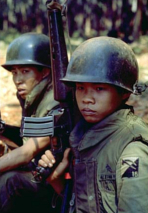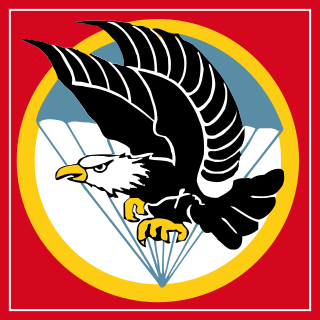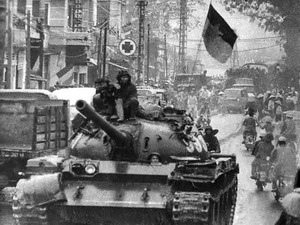
The fall of Saigon was the capture of Saigon, the capital of South Vietnam, by North Vietnam on 30 April 1975. The event marked the end of the Vietnam War and the collapse of the South Vietnamese state, leading to a transition period and the formal reunification of Vietnam into the Socialist Republic of Vietnam under communist rule on 2 July 1976.

Operation Frequent Wind was the final phase in the evacuation of American civilians and "at-risk" Vietnamese from Saigon, South Vietnam, before the takeover of the city by the North Vietnamese People's Army of Vietnam (PAVN) in the Fall of Saigon. It was carried out on 29–30 April 1975, during the last days of the Vietnam War. More than 7,000 people were evacuated by helicopter from various points in Saigon. The airlift resulted in a number of enduring images.

The Battle of Xuân Lộc was the last major battle of the Vietnam War that took place at Xuân Lộc, Đồng Nai Province. Over a period of twelve days between 9 and 21 April 1975, the outnumbered South Vietnamese reserves attempted to stop the North Vietnamese forces from overrunning the town and breaking through towards South Vietnam's capital, Saigon. The Army of the Republic of Vietnam (ARVN) committed almost all their remaining mobile forces, especially the 18th Division, under Brigadier General Lê Minh Đảo, to the defence of the strategic crossroads town of Xuân Lộc, hoping to stall the People's Army of Vietnam (PAVN) advance. The battle ended when the town of Xuân Lộc was captured by the PAVN 4th Army Corps led by Major General Hoàng Cầm.

Bien Hoa Air Base is a Vietnam People's Air Force (VPAF) military airfield located in South-Central southern Vietnam about 25 km from Ho Chi Minh City, across the Dong Nai river in the northern ward of Tân Phong, and within the city of Biên Hòa within Đồng Nai Province. The boomburb city is densely populated and rings the base, despite significant levels of Agent Orange toxins simply left there for decades. Cleanup and remediation began in 2019.

Phan Rang Air Base is a Vietnam People's Air Force (VPAF) (Khong Quan Nhan Dan Viet Nam) military airfield in Vietnam. It is located 5.2 miles north-northwest of Phan Rang – Tháp Chàm in Ninh Thuận Province.

Tan Son Nhut Air Base (1955–1975) was a Republic of Vietnam Air Force (RVNAF) facility. It was located near the city of Saigon in southern Vietnam. The United States used it as a major base during the Vietnam War (1959–1975), stationing Army, Air Force, Navy, and Marine units there. Following the Fall of Saigon, it was taken over as a Vietnam People's Air Force (VPAF) facility and remains in use today.

The 1975 spring offensive, officially known as the general offensive and uprising of spring 1975, was the final North Vietnamese campaign in the Vietnam War that led to the capitulation of Republic of Vietnam. After the initial success capturing Phước Long Province, the North Vietnamese leadership increased the scope of the People's Army of Vietnam's (PAVN) offensive and captured and held the key Central Highlands city of Buôn Ma Thuột between 10 and 18 March. These operations were intended to be preparatory to launching a general offensive in 1976.

The South Vietnam Air Force, officially the Republic of Vietnam Air Force, was the aerial branch of the Republic of Vietnam Military Forces, the official military of the Republic of Vietnam from 1955 to 1975.

Da Nang Air Base (1930s–1975) was a French Air Force and later Republic of Vietnam Air Force (RVNAF) facility located in the city of Da Nang, Vietnam. During the Vietnam War (1959–1975), it was a major base with United States Army, United States Air Force (USAF), and United States Marine Corps (USMC) units stationed there. Air Vietnam also used the facility from 1951 to 1975 for civilian domestic and international flights within Southeast Asia.

Phase Two of the Tet Offensive of 1968 was launched by the People's Army of Vietnam (PAVN) and Viet Cong (VC) against targets throughout South Vietnam, including Saigon from 29 April to 30 May 1968. The May Offensive was considered much bloodier than the initial phase of the Tet Offensive. U.S. casualties across South Vietnam were 2,169 killed for the entire month of May, making it the deadliest month of the entire Vietnam War for U.S. forces, while South Vietnamese losses were 2,054 killed. PAVN/VC losses exceeded 24,000 killed and over 2,000 captured. The May Offensive was a costly defeat for the PAVN/VC.

The Vietnamese Airborne Division or VNAD was one of the earliest components of the Republic of Vietnam Military Forces. The Vietnamese Airborne Division began as companies organized in 1948, prior to any agreement over armed forces in Vietnam. After the partition of Vietnam, it became a part of the Army of the Republic of Vietnam. This division had its distinct origins in French-trained paratrooper battalions, with predecessor battalions participating in major battles including Dien Bien Phu and retained distinct uniforms and regalia. With the formation of an independent republic, the colonial paratroopers were dissolved, however regalia and aesthetics alongside the nickname "Bawouans" would be retained.
1st Corps or Quyết thắng Corps was a regular army corps of the People's Army of Vietnam (PAVN). First organised in 1973 during the Vietnam War, 1st Corps had a major role in the 1975 spring offensive that ended the war. Before disbanding on 21 November 2023, the corps was stationed in Tam Điệp, Ninh Bình.

1975 marked the end of the Vietnam War. The North Vietnamese People's Army of Vietnam (PAVN) launched the Spring Offensive in March; the South Vietnamese Army of the Republic of Vietnam (ARVN) was quickly defeated. The North Vietnamese captured Saigon on April 30, accepting the surrender of South Vietnam. In the final days of the war, the United States, which had supported South Vietnam for many years, carried out an emergency evacuation of its civilian and military personnel and more than 130,000 Vietnamese.

The Hue–Da Nang Campaign was a series of military actions conducted by the People's Army of Vietnam (PAVN) against the Army of the Republic of Vietnam (ARVN) during the Vietnam War, also known in Vietnam as the American War. The campaign was centred on the cities of Huế and Da Nang, with secondary fronts in the provinces of Quảng Trị and Quảng Ngãi. The campaign began on March 5 and concluded on April 2, 1975.

The Vietnam People's Air Force, officially the Air Defence - Air Force Service or the Vietnam Air Force, is the aerial and air defence service branch of Vietnam. It is the modern incarnation of the so-called North Vietnamese Air Force (NVAF) and absorbed the South Vietnamese Air Force (RVNAF/VNAF) following the reunification of Vietnam in 1975 and is one of three main branches of the People's Army of Vietnam, which is under the executive administration of the Ministry of National Defence. The main mission of the VPAF is the defence of Vietnamese aerospace and the provision of air and space cover for operations of the People's Army of Vietnam.
The 325th Infantry Division is a division of the People's Army of Vietnam (PAVN), first formed in March 1951 from independent units in Thừa Thiên, it is likely that it only became fully operational in mid-1952. It was one of the 6 original "Iron and Steel" Divisions of the Viet Minh.

The Zone 5 Military Museum is a military museum located at 3 Duy Tân, Da Nang, Vietnam. It covers all Vietnamese resistance to foreign occupation from the Chinese occupation, the First Indochina War with the French, the Vietnam War and the current standoff with China over the Spratly Islands and the Paracel Islands.

The attack on Tan Son Nhut Air Base, headquarters of the Republic of Vietnam Air Force (RVNAF) and the United States Air Force (USAF) 7th Air Force, occurred during the early hours of 31 January 1968. Tan Son Nhut Air Base was one of the major air bases used for offensive air operations within South Vietnam and for the support of United States Army and Army of the Republic of Vietnam (ARVN) ground operations. The attack by Vietcong (VC) and People's Army of Vietnam (PAVN) forces was one of several major attacks on Saigon in the first days of the Tet offensive. The attack was repulsed with the VC/PAVN suffering heavy losses; only superficial damage was done to the base.
The 10th Infantry Division is a division of the People's Army of Vietnam (PAVN), first formed in September 1972.

Nguyễn Thành Trung is a Vietnamese military and civilian aviator. Trung fought during the Vietnam War and later became an executive of Vietnam Airlines.





















